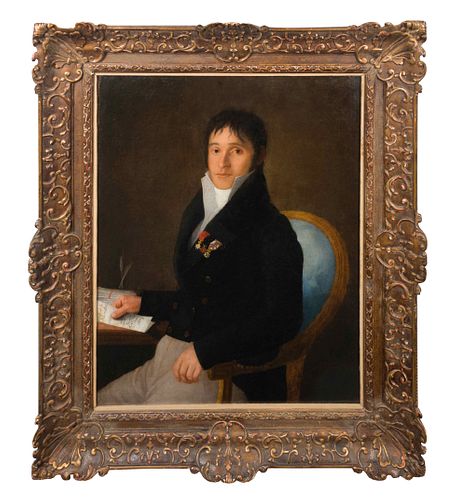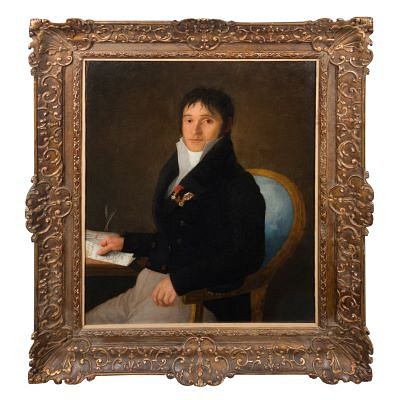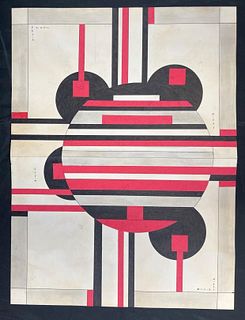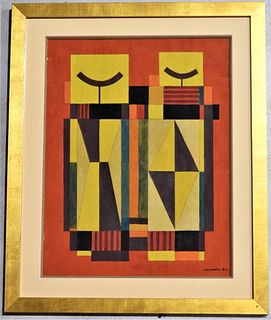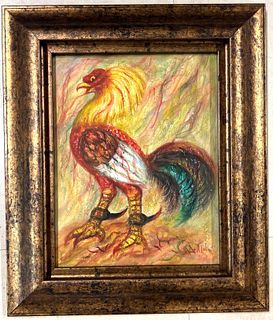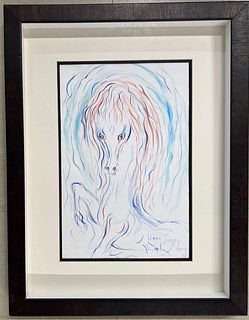Attributed to Jose Ribelles y Helip (Spanish, 1778-1835)
Lot 249
About Seller
Hindman
1338 West Lake Street
Chicago, IL 60607
United States
Recognized as the Midwest's leading fine art auctioneers, Hindman Auctioneers has built a worldwide reputation based on a full service approach to the auction business tailored to meet the individual needs of our clients. Coming from a variety of educational backgrounds, specialists bring years of e...Read more
Estimate:
$3,000 - $5,000
Absentee vs Live bid
Two ways to bid:
- Leave a max absentee bid and the platform will bid on your behalf up to your maximum bid during the live auction.
- Bid live during the auction and your bids will be submitted real-time to the auctioneer.
Bid Increments
| Price | Bid Increment |
|---|---|
| $0 | $25 |
| $500 | $50 |
| $1,000 | $100 |
| $2,000 | $250 |
| $5,000 | $500 |
| $10,000 | $1,000 |
| $20,000 | $2,500 |
| $50,000 | $5,000 |
| $100,000 | $10,000 |
About Auction
By Hindman
Jul 21, 2020
Set Reminder
2020-07-21 10:00:00
2020-07-21 10:00:00
America/New_York
Bidsquare
Bidsquare : Fine Furniture, Decorative Arts and Silver
https://www.bidsquare.com/auctions/hindman-auctions/fine-furniture-decorative-arts-and-silver-5281
Hindman Bidsquare@hindmanauctions.com
Hindman Bidsquare@hindmanauctions.com
- Lot Description
Attributed to Jose Ribelles y Helip (Spanish, 1778-1835)
Don Juan Jose Perez Mora
oil on canvas
40 1/8 x 31 1/2 inches.
Provenance:
Arthur Tooth & Son, London
Moulton & Ricketts, Chicago
Purchased by Hackley Art Gallery, June 3, 1913, through the Hackley Picture Fund
Literature:
Wyer, Raymond, ed. Aesthetics, vol. I (Muskegon, Michigan: Hackley Art Gallery, 1913), pp. 54-57.
Levy, Florence M., ed. American Art Directory, vol. XI (New York: American Federation of the Arts, 1914), p. 170.
Official Catalogue of Exhibitors: Panama-Pacific International Exposition, San Francisco, California, 1915 (San Francisco: The Wahlgreen Company, 1915), p. 20.
Howard, Rossiter. Art at the Panama-Pacific Exposition, vol. 32 (Fine Arts Journal, June 1915), pp. 264-270, no. 6.
Wyer, Raymond, ed. Aesthetics, vol. IV (Muskegon, Michigan: Hackley Art Gallery, 1916), p. 37, nos. 3-4.
Starkweather, William E. B. Paintings and Drawings by Francisco Goya in the Collection of the Hispanic Society of America (New York: The Hispanic Society of America, 1916), p. 223.
Federal Writers' Project of the Works Projects Administration in the State of Michigan. A Guide to the Wolverine State (New York: Oxford University Press, 1949), p. 356
Exhibited:
Panama-Pacific International Exposition, San Francisco, 1915
Spanish Art Exhibition, Fine Arts Gallery, San Diego, California, January 1928
Midland Art Association, Michigan Museum Show, Midland, Michigan, April 28-May 11, 1957
Lot Essay:
The Hackley Art Gallery (ultimately named the Muskegon Museum of Art) acquired this portrait on June 3, 1913 as a work attributed to Francisco Jose de Goya y Lucientes (Spanish, 1746-1828). Raymond Wyer, the gallery's first director, conducted the purchase, which was the most expensive painting ever acquired through the Hackley Picture Fund. The above referenced article in Aesthetics, vol. IV, published by the Hackley Art Gallery, designates the portrait as "one of the most important paintings in our permanent collection. [i] The sitter, Don Juan Jose Perez Mora, was an influential civilian and military administrator for the city of Madrid. He is depicted holding a letter in his right hand inscribed in Spanish "Madrid, 10 July 1810. Administration of Madrid. Concerning the most noble Don Juan Jose Perez Mora." This same inscription is printed in English on an old paper label affixed to this painting's stretcher.
In 1915, the Art Committee of the United States invited the Hackley Art Gallery to loan six paintings from its permanent collection to hang at the Panama-Pacific Exposition in San Francisco, the most of any museum in the world. [ii] This portrait is specifically referenced by Rossiter Howard, a prominent art educator and one-time director of the Kansas City Art Institute: "Goya's Don Juan Jose gives us the feeling of the same period in Spain, though Goya stood alone, rather than as one of a group, in his expression of it [...] The character is drawn so that we feel it keenly, the modeling is vigorous and fine, and the composition is sensitive. The painting would stand high among the Goyas of Madrid. [iii]
On February 9, 1929, Juan-Allende Salazar, a Spanish art scholar and trustee of the Prado, called into question the Goya attribution in a letter to the Hackley Art Gallery, and argued that the painting was likely by Jose Ribelles y Helip (Spanish, 1778-1835) instead. In a letter dated April 15, 1946, Professor Martin S. Soria, an art historian in the Spanish Department at Princeton University, voiced similar concerns regarding the Goya attribution, and reaffirmed Salazar's identification of Jose Ribelles y Helip as the true artist. His letter states: "I had felt that Jose Ribelles y Helip was probably the author of your picture. I have recently been able to check this attribution by comparison with various photographs of authentic portraits by this master in Spain. My conclusion is that Juan Jose Perez Mora is a work by Jose Ribelles [...] As to the date of the picture, your discussion is very convincing and I fear that for the time being it must remain 1810 or 1818. The decorations are, from the spectator's left: Order of St. John of Malta, Order of the Holy Sepulchre, Order of St. Ferdinand. [iv] The Muskegon Museum of Art no longer possesses the two aforementioned letters in their archives. The documentation provided for this lot is courtesy of the Muskegon Museum of Art.
Charles H. Hackley (1837-1905) was born in Michigan City, Indiana, and made his fortune in Muskegon's then thriving lumber industry as the owner of the Hackley-Hume Lumber Mill from 1854-1894. While many lumber mill owners eventually moved their operations to the Pacific Northwest, Hackley remained in Muskegon and emerged as a preeminent philanthropist in the once prosperous former industrial center. Among his numerous endeavors, Hackley envisioned opening a municipal art gallery for the city, and left through a bequest in his will an expendable trust of $150,000 to the Muskegon Public Schools Board of Education, a fund that ultimately came to be known as the Hackley Picture Fund. Hackley stated in his will that the fund was established for the purpose of purchasing "pictures of the best kind," and in 1910, Muskegon's Board of Education broke ground on a facility meant to house their growing collection of fine art, ultimately culminating in the opening of the Hackley Art Gallery. In 1979, the Hackley Art Gallery, also known as the Hackley Art Museum, underwent significant renovation and was renamed the Muskegon Museum of Art. [i] Wyer, Raymond, ed. Aesthetics, vol. IV (Muskegon, Michigan: Hackley Art Gallery, 1916), p. 37, nos. 3-4.
[ii] Howard, Rossiter. Art at the Panama-Pacific Exposition, vol. 32 (Fine Arts Journal, June 1915), p. 265.
[iii] Howard, Rossiter. Art at the Panama-Pacific Exposition, vol. 32 (Fine Arts Journal, June 1915), p. 267.
[iv] Professor Martin S. Soria, letter to the Hackley Art Gallery, April 15, 1946.
[v]'History.' The Muskegon Museum of Art. http://muskegonartmuseum.org/history/
Property from the Muskegon Museum of Art, Muskegon, MichiganFrame: 52 1/2 x 43 3/4 inches. Canvas is lined. Craquelure throughout; light surface dirt. The painting was previously thought to be circa 1810, but may be later. Accession number: 13.57Condition
For condition inquiries please contact fdcr@hindmanauctions.com - Shipping Info
-
Please refer to https://hindmanauctions.com/shipping-packing
-
- Buyer's Premium



 EUR
EUR CAD
CAD AUD
AUD GBP
GBP MXN
MXN HKD
HKD CNY
CNY MYR
MYR SEK
SEK SGD
SGD CHF
CHF THB
THB